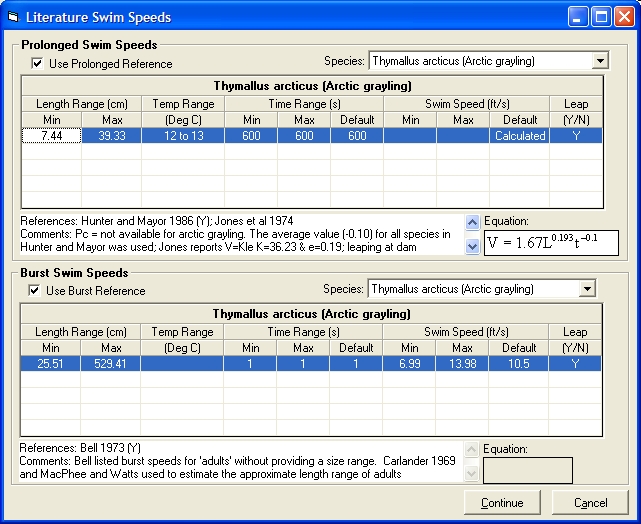|
To view the complete table click here, View Swim Speed Table

FishXing includes a table that contains swim performance information for various species. The performance information was compiled from the available literature and is of two basic types: 1) burst and prolonged swimming speeds (cm/s); and 2) swim speed equations that calculate swimming speeds using factors that influence swim speed such as time to exhaustion and/or fish length. The variability regarding the swimming speed estimate was included when available.
The table also includes useful information about the conditions of the tests from which the swimming speeds or equations were derived such as: length of the fish, type of swimming test, test variables (time to exhaustion, and time between velocity increases), water temperature, comments about test procedure or the reliability of the swimming speed estimate, and literature cited.
Selecting Burst and Prolonged Swim Speeds
The Swim Speed Window contains two grids that show a subset of the data compiled in the complete table. The data shown are intended to inform your decision as to which (if any) lines to use as your analysis fish. If the particular reference cited included the following information then it is included in the table: Fish Length Range, Water Temperature in which experiment was conducted, Time Range (depends on experimental method used), Swim Speed Range, and whether the species is known to leap. For each line in the table the References and any comments made during compilation of the information.
Use Prolonged Reference and Use Burst Reference Check Boxes
This window requires you to select one reference for Prolonged swimming and one for Burst unless one of these check boxes is unchecked. If an analysis using only Burst or only Prolonged swimming is desired, uncheck the box associated with the other speed mode and a reference for that mode will no longer be required. Upon return to the main Input page the appropriate mode will be selected (Burst or Prolonged).
See Prolonged / Use Both / Burst:
Selecting Species
Choose a species from either the Prolonged or Burst Species drop-down lists. The first time you choose a species, if there is a corresponding entry in the other list it will be shown. For example, upon opening the form you go to the Prolonged Species list and choose Lampetra tridentate. This species will show up in both the Prolonged and Burst grids. However, if you now change either species, the other one will not change.
Each grid will show a list of references available for that species. You can choose one from each list that most closely represents the species, size class, and water temperature range for the analysis being performed.
Link to Fish Performance
The complete Swim Speeds Table can be viewed by clicking here: Swim Speeds Table. More information about fish performance can be viewed by clicking here: Fish Performance.
Calculated Speeds
If the word “Calculated” appears in the default swim speed column it means that the swim speeds derived from that reference are dependent on Fish Length, Time to Exhaustion, or both. When the reference is chosen the equation used will show in the Equation box. If the reference is used, upon return to the main Input page, the swim speeds will be calculated. If you change either the fish length or time to exhaustion the speed will be recalculated dynamically.
Length Range – shows the range of fish total lengths used in the research associated with each reference which was provided by the author.
Temp Range – shows the range of water temperatures used in the research associated with each reference which was provided by the author.
Time Range – shows the range of times to exhaustion used in the research associated with each reference which was provided by the author. If it was not provided default values of 5 seconds for burst and 30 minutes for prolonged were inserted in the table.
Swim Speed – shows the range of fish swimming speeds observed in the research associated with each reference which was provided by the author. The default swim speed was derived from some measure of central tendency of the range of speeds. The measures used are shown in the complete Swim Speeds Table.
Leap – indicates whether the species is known to leap. In many cases this is not known and it is assumed that the fish can leap. If a fish is not a leaper then the outlet criteria is set to Max Leap Speed and the Maximum Leap Speed is defaulted to zero indicating that the fish is unable to negotiate a leap of any magnitude.
References and Comments – for the selected line in the grid are shown in the box below each grid.